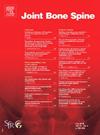Femoral neck shape and trabecular bone microarchitecture association with hip osteoarthritis – Results from the QUALYOR study
IF 3.8
3区 医学
Q1 RHEUMATOLOGY
引用次数: 0
Abstract
Objectives
Hip osteoarthritis (OA) is a major public health concern. The determinants of hip OA, however, are not as well understood as those of other OA sites, such as the knee. In recent years, the role of subchondral bone in the pathogenesis of OA has been emphasized but data are lacking for hip OA. Therefore, we aimed to determine which bone characteristics were associated to hip OA.
Methods
We made a cross-sectional analysis of 1537 postmenopausal women included in the QUALYOR prospective cohort. At baseline, we measured areal BMD by DXA at the lumbar spine and the hip, volumetric BMD and geometry by hip quantitative computerized tomography (QCT) using the Bone Investigational Toolkit (BIT) software, as well as microarchitecture at the distal radius and tibia by high-resolution peripheral quantitative tomography (HR-pQCT). We built a hip OA score (CT OA score) with images from the hip QCT, based on the depiction of the four major signs of osteoarthritis: subchondral bone sclerosis, joint space narrowing, osteophytes and subchondral cysts. The severity of each of these four signs was graded as absent, mild, moderate or severe (semi-quantitative score ranging from 0 to 3 for each sign). The absence of hip OA was defined as CT score equal to 0, mild hip OA as CT score between 1 and 4 and moderate to severe hip OA as CT score > 4. Women with and without hip OA were compared using t tests and multivariable modeling.
Results
The mean age was 65.9 (±6.7) years and the mean body mass index was 24.6 (±3.6) kg/m2. Among these 1537 women, 601 had an OA score of 0, 756 between 1 and 4 (mild OA) and 180 greater than 4 (severe OA). Women with hip osteoarthritis had lower trabecular total hip vBMD (125 vs. 129 mg/cm3, P < 0.01). Cortical hip vBMD did not differ between women with and without hip OA (966.5 vs. 963.5 mg/cm3, P n.s). Patients with hip OA also had larger femoral neck volume (11.55 vs. 11.27 mm3, P < 0.001). The BIT analysis showed greater bone resistance to bending (cross-sectional moment of inertia [CSMI] min with 6.03 vs. 5.6 cm4 and section modulus [Z] polar with 7.98 vs. 7.59 cm3, P < 0.05) at the femoral neck in patients with mild hip OA and even greater in women with severe hip OA. Patients with hip OA had significantly higher trabecular area measured at the radius by HR-pQCT (205.11 vs. 192.61 mm2, between group difference 12.50 95% CI [8.15–16.86] P < 0.01), lower trabecular number at the tibia (1.57/μm vs. 1.63/μm, between group difference −0.06 95% CI [−0.09 to −0.03] P < 0.001) and higher trabecular spacing at the tibia (0.58 vs. 0.56 μm, between group difference 0.02 95% CI [0.011–0.038] P < 0.005). Cortical parameters were not different in patients with hip OA compared to controls.
Conclusion
Women with hip OA have larger femoral neck and lower trabecular bone parameters, suggesting a sizeable role of hip bone geometry and remodeling in the pathophysiology of hip OA.

股骨颈形状和骨小梁微结构与髋关节骨关节炎的关系——来自QUALYOR研究的结果。
目的:髋关节骨关节炎(OA)是一个主要的公共卫生问题。然而,髋关节骨关节炎的决定因素并不像其他骨关节炎部位(如膝盖)的决定因素那样清楚。近年来,软骨下骨在骨性关节炎发病机制中的作用已被强调,但缺乏有关髋关节骨性关节炎的数据。因此,我们的目的是确定哪些骨骼特征与髋关节OA相关。方法:我们对纳入QUALYOR前瞻性队列的1537名绝经后妇女进行了横断面分析。基线时,我们使用DXA测量腰椎和髋部的面积骨密度,使用骨研究工具包(BIT)软件使用髋部定量计算机断层扫描(QCT)测量体积骨密度和几何形状,以及使用高分辨率外周定量断层扫描(HRpQCT)测量桡骨远端和胫骨的微结构。我们根据骨关节炎的四个主要症状:软骨下骨硬化、关节间隙狭窄、骨赘和软骨下囊肿的描述,利用髋关节QCT图像建立了髋关节OA评分(CT OA评分)。这四个症状的严重程度分别分为无、轻度、中度和严重(每个症状的半定量评分范围从0到3)。无骨关节炎定义为CT评分为0分,轻度骨关节炎定义为CT评分为1 ~ 4分,中重度骨关节炎定义为CT评分为bb0 ~ 4分。使用t检验和多变量模型对有和没有髋关节骨关节炎的妇女进行比较。结果:平均年龄65.9(+/-6.7)岁,平均体重指数24.6 (+/-3.6)kg/m2。在这1537名女性中,601名OA评分在1到4分之间为0.756分(轻度OA), 180名评分大于4分(重度OA)。患有髋关节骨性关节炎的女性有较低的髋小梁总vBMD (125 vs 129 mg/cm3, p3, p n.s)。髋部OA患者股骨颈体积较大(11.55 vs 11.27 mm3, p4和截面模量(Z)极值分别为7.98 vs 7.59 cm3, p < 2,组间差异为12.50 CI95% [8.15-16.86] p < 0.01),胫骨小梁数较低(1.57 /µm vs 1.63/µm,组间差异为-0.06 CI95% [-0.09;-0.03] p < 0.001),胫骨小梁间距较大(0.58 vs 0.56µm,组间差异为0.02 CI95% [0.011-0.038] p < 0.005)。与对照组相比,髋关节OA患者的皮质参数没有差异。结论:女性髋关节骨性关节炎患者股骨颈和下骨小梁参数较大,表明髋骨几何形状和重塑在髋关节骨性关节炎的病理生理中起着相当大的作用。
本文章由计算机程序翻译,如有差异,请以英文原文为准。
求助全文
约1分钟内获得全文
求助全文
来源期刊

Joint Bone Spine
医学-风湿病学
CiteScore
4.50
自引率
11.90%
发文量
184
审稿时长
25 days
期刊介绍:
Bimonthly e-only international journal, Joint Bone Spine publishes in English original research articles and all the latest advances that deal with disorders affecting the joints, bones, and spine and, more generally, the entire field of rheumatology.
All submitted manuscripts to the journal are subjected to rigorous peer review by international experts: under no circumstances does the journal guarantee publication before the editorial board makes its final decision. (Surgical techniques and work focusing specifically on orthopedic surgery are not within the scope of the journal.)Joint Bone Spine is indexed in the main international databases and is accessible worldwide through the ScienceDirect and ClinicalKey platforms.
 求助内容:
求助内容: 应助结果提醒方式:
应助结果提醒方式:


